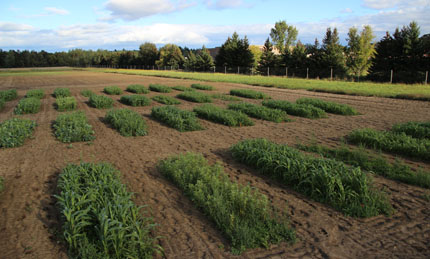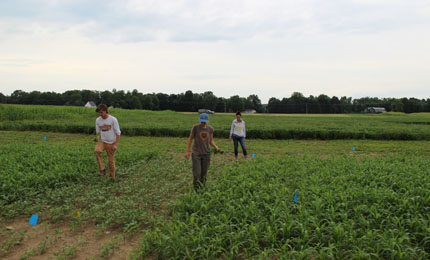5585 Guilford Road • Madison, WI 53711-5801 • 608-273-8080 • Fax 608-273-2021
www.agronomy.org
Twitter | Facebook
NEWS RELEASE
Contact: Hanna Jeske, Associate Director of Marketing and Brand Strategy, 608-268-3972, hjeske@sciencesocieties.org
Intercropping: Intersection of soil health, production
Sept. 21, 2016 - Plant scientist Ann Bybee-Finley says her first field experiment was humbling. ”I felt like a very small scientist in a very big world,” she said.
 Bybee-Finley researches intercropping at Cornell University. Intercropping is a complex practice of farming where different plant species are grown in the same space. Most conventional farmers only plant one crop per field or plot. This practice, called monoculture farming, is more convenient for farmers, but it can make the plants more vulnerable. For example, if one plant gets a disease, the others are likely to catch it. Weeds are more likely to find a home in spaces that are very similar. As a result, monoculture farming can be dependent on expensive synthetic chemicals to ward off weeds and diseases.
Bybee-Finley researches intercropping at Cornell University. Intercropping is a complex practice of farming where different plant species are grown in the same space. Most conventional farmers only plant one crop per field or plot. This practice, called monoculture farming, is more convenient for farmers, but it can make the plants more vulnerable. For example, if one plant gets a disease, the others are likely to catch it. Weeds are more likely to find a home in spaces that are very similar. As a result, monoculture farming can be dependent on expensive synthetic chemicals to ward off weeds and diseases.
Droughts and other weather events can also damage entire monoculture fields. Bybee-Finley says a bad drought in 2012 shaped her vision of agriculture. “The stories of crop failure made me want to understand how to make farming practices more resilient, especially as climate change makes extreme weather events more frequent.”
Intercropping gives farmers more options if one of their crops fails. “It’s like a diversified stock portfolio,” said Bybee-Finley. Plant diversity leads to more diversity below ground too. Plants that add organic matter and nutrients when they decompose replenish the soil.
In her experiment, Bybee-Finley planted four cover crops, which are plants that add fertility to the soil and protect it from erosion. She planted two grasses, pearl millet and sorghum, and two legumes, cowpea and sunn hemp. The grasses are well known for their ability to add organic matter to tired soils whose nutrients have been depleted by years of farming. Legumes are also good for the soil because their roots release nitrogen when they decompose. These cover crops are also a feed source for cows and other livestock, providing farmers another source of income.
 In her experiment, Bybee-Finley found the grasses and legumes that grew at the same pace were more productive because they weren’t competing for space and resources as much as plants that grew at different rates. On the other hand, she found that some plant combinations grew more, while others had more nitrogen.
In her experiment, Bybee-Finley found the grasses and legumes that grew at the same pace were more productive because they weren’t competing for space and resources as much as plants that grew at different rates. On the other hand, she found that some plant combinations grew more, while others had more nitrogen.
“I’m sure there’s a sweet spot,” said Bybee-Finley, “There’s so many unexplored avenues and questions to ask: Which species should I plant together? And how many of each?”
Bybee-Finley said the next step for this experiment is to see which plant combinations were the most nutritious for animals.
For experiments with lots of variables like this one, Bybee-Finley says you end up with a complex set of conclusions. “When you’re looking at an entire system it makes it harder to have an immediate take-away,” she said. “It takes longer to come up with a definite conclusion.”
But Bybee-Finley is comfortable with complexity. “Diversity begets diversity,” she said. “Agricultural science is beginning to look beyond the simplified strategy of planting only one crop per rotation.
For Bybee-Finley, intercropping is full of tradeoffs, and the life lesson of agriculture is that plants don’t always behave the way you expect them to. “The miracle of biology is that plants, no matter what you do, will do exactly what they want to do.”
Read more about this research in Crop Science. Cornell University, National Institute of Food and Agriculture, U.S. Department of Agriculture, Hatch Project 2013-14-425: Expanding the role of cover crops in sustainable cropping systems, and NE SARE Graduate Student Project GNE14-073 funded this research.
Crop Scienceis the flagship journal of the Crop Science Society of America. It is a top international journal in the fields of crop breeding and genetics, crop physiology, and crop production. The journal is a critical outlet for articles describing plant germplasm collections and their use.